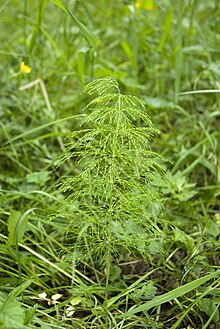Equisetales
| Equisetales Temporal range: | |
|---|---|
 | |
| Equisetum sylvaticum in France | |
| Scientific classification | |
| Kingdom: | Plantae |
| Clade: | Tracheophytes |
| Division: | Polypodiophyta |
| Class: | Polypodiopsida |
| Subclass: | Equisetidae |
| Order: | Equisetales DC. ex Bercht. & J. Presl |
| Families | |
Equisetales is an order of subclass Equisetidae with only one living family, Equisetaceae, containing the genus Equisetum (horsetails), as well as a variety of extinct groups, including the tree-like Calamitaceae.
Classification
[edit]In the molecular phylogenetic classification of Smith et al. in 2006, Equisetales, in its present circumscription, was held to be the sole member of class Equisetopsida.[1] The linear sequence of Christenhusz et al. (2011), intended for compatibility with the classification of Chase and Reveal (2009)[2] which placed all land plants in Equisetopsida,[3] made it the sole member of subclass Equisetidae, equivalent to Smith's Equisetopsida.[2] The placement of Equisetales in subclass Equisetidae has subsequently been followed in the classifications of Christenhusz and Chase (2014)[4] and PPG I (2016).[5]
The fossil record includes additional extinct species in Equisetaceae and the extinct families Calamitaceae, Archaeocalamitaceae and Phyllothecaceae.[6][7]
Cladogram after Elgorriaga et al, 2018.[8]
| Equisetales | |
References
[edit]- ^ Smith, Alan R.; Pryer, Kathleen M.; Schuettpelz, Eric; Korall, Petra; Schneider, Harald; Wolf, Paul G. (August 2006). "A classification for extant ferns" (PDF). Taxon. 55 (3): 705–731. doi:10.2307/25065646. JSTOR 25065646. Archived from the original (PDF) on 2021-12-09. Retrieved 2016-12-22.
- ^ a b Christenhusz, Maarten J. M.; Zhang, Xian-Chun; Schneider, Harald (18 February 2011). "A linear sequence of extant families and genera of lycophytes and ferns" (PDF). Phytotaxa. 19: 7–54. doi:10.11646/phytotaxa.19.1.2. hdl:10138/28042.
- ^ Chase, Mark W.; Reveal, James L. (October 2009). "A phylogenetic classification of the land plants to accompany APG III". Botanical Journal of the Linnean Society. 161 (2): 122–127. doi:10.1111/j.1095-8339.2009.01002.x.
- ^ Christenhusz, Maarten J. M.; Chase, Mark W. (13 February 2014). "Trends and concepts in fern classification". Annals of Botany. 113 (4): 571–594. doi:10.1093/aob/mct299. PMC 3936591. PMID 24532607.
- ^ The Pteridophyte Phylogeny Group (November 2016). "A community-derived classification for extant lycophytes and ferns". Journal of Systematics and Evolution. 54 (6): 563–603. doi:10.1111/jse.12229.
- ^ Stanich, Nicholas; Gar W. Rothwell; Ruth A. Stockey (2009). "Phylogenetic diversification of Equisetum (Equisetales) inferrred from Lower Cretaceous species of British Columbia, Canada". American Journal of Botany. 96 (7): 1289–1299. doi:10.3732/ajb.0800381. PMID 21628278.
- ^ Uma nova espécie de Phyllotheca Brongniart
- ^ Elgorriaga, Andrés; Escapa, Ignacio H.; Rothwell, Gar W.; Tomescu, Alexandru M. F.; Rubén Cúneo, N. (August 2018). "Origin of Equisetum : Evolution of horsetails (Equisetales) within the major euphyllophyte clade Sphenopsida". American Journal of Botany. 105 (8): 1286–1303. doi:10.1002/ajb2.1125. ISSN 0002-9122.
External links
[edit] Media related to Equisetales at Wikimedia Commons
Media related to Equisetales at Wikimedia Commons


 French
French Deutsch
Deutsch